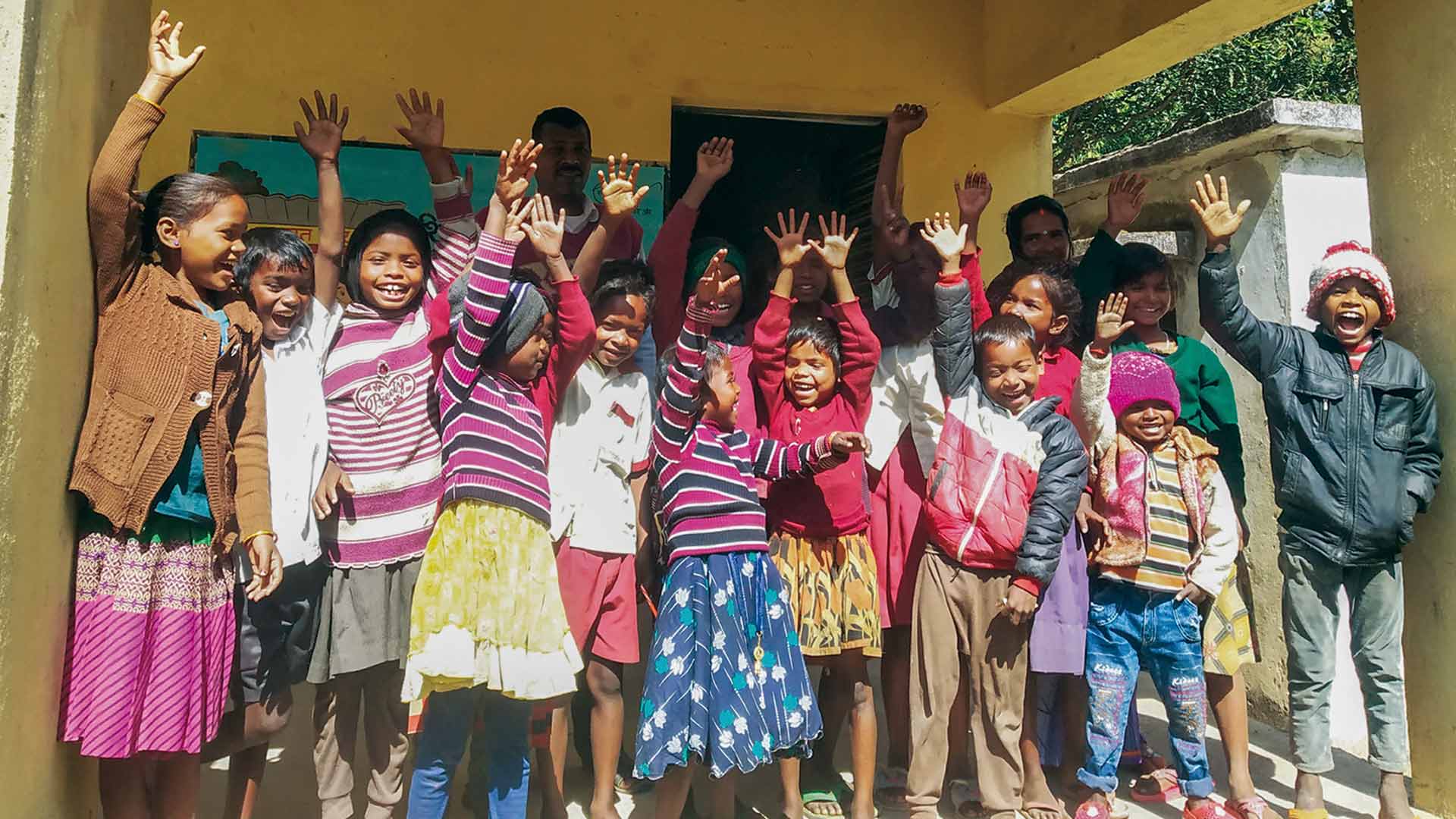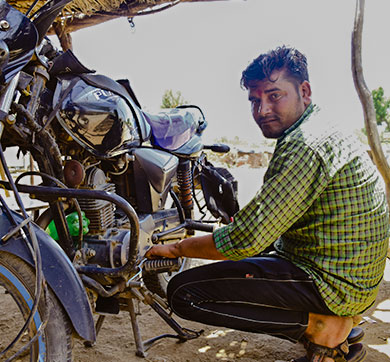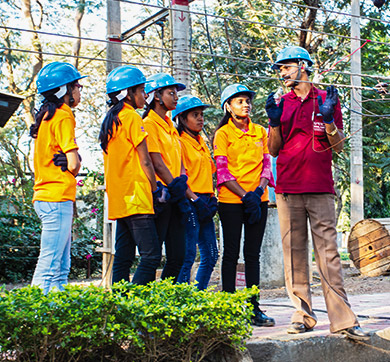July 2023 | 1706 words | 6-minute read
Sumathi (name changed) pores over a page, making a crayon sketch of ‘life during the pandemic’. The daughter of migrant workers who were stuck in Bengaluru due to the countrywide Covid lockdowns, the Std V student’s drawing depicts one of the misfortunes visited on her family during that traumatic time: her parents quarantined in a jail-like structure, separated from their nearest.
Sumathi’s plight was not hers alone. Hundreds of thousands of children around India suffered as Covid burned its way through the world, many uncounted going to bed hungry as schools stopped providing cooked food or rations. As the lockdowns continued and schools remained shut for 18 months and more, students living in areas with poor or no internet connectivity gradually lost their grasp of alphabets and numbers. Cases of early marriage, child labour and trafficking rose, as did drug and alcohol abuse.
These glimpses into Covid’s impact on the lives and education of India’s children are chronicled in a Tata Trusts-supported research study featuring about 1,200 children, and an equal number of parents, across 12 blocks (subdistricts) of Jharkhand, Rajasthan, Uttar Pradesh and Karnataka. The blocks covered were already ranked low on development metrics; Covid rendered their condition dire.

Released in June 2022, this first-of-its-kind study was undertaken by the Delhi-based Council for Social Development (CSD), with a team that reached out to government officials, panchayat (village council) members, teachers and school authorities. The focus was on rural and marginalised families, including migrants.
The researchers paid particular attention to the experiences of children during the closure and reopening of schools. Going beyond recording gaps in their learning, they looked at how widespread unemployment, prolonged school closures and other shocks impacted the access children had to education, health and social protection.
The child rights perspective is critical here. “Framing these issues in the context of children being deprived of their fundamental rights is the best way to get society to take note of, and seriously address, these issues,” says Kishore Darak, manager, education, at the Tata Trusts.
The pandemic's shadow
The study assessed the efficacy of relief interventions by the union and state governments and non-state players such as nonprofits. Its analyses are distilled into targeted recommendations (see Covid and after, right) necessary to help children still affected by the pandemic’s long shadow.
For the Trusts, the report has revealed several insights about the state of education in their project areas. “The Trusts-CSD report is a holistic effort; its findings have the potential of informing our programmatic design and strategies,” adds Mr Darak.
The lockdowns unleashed an economic crisis that affected millions of low-wage, informal-sector workers. This was reflected in the study, where adult participants were mainly seasonal workers living in rural or semi-rural regions. With many of these workers losing their jobs, unemployment rose by 20%. Nine out of 10 surveyed households reported a loss of livelihood. Government-run relief schemes dulled these financial shocks, but only to a limited extent.
Covid and after
Conducted in January-March 2022, the Tata Trusts-Council for Social Development study covered:
- 12 subdistricts in Jharkhand, Rajasthan, Uttar Pradesh and Karnataka
- 14 schools and anganwadis (childcare centres)
- 1,200 students; 1,200 parents; and 240 teachers and anganwadi workers, government officials, NGOs and village council members.
Financial distress forced parents to make harsh choices. The study found that about 15% of students were shifted from private to state-run schools to save money on fees. Girls bore the brunt in these cutbacks. “Parents typically preferred to give their sons a better education in private schools, while their daughters would be sent to state-run schools,” says Dr Nitya Nanda, director, CSD.
By recording how the pandemic deepened long-standing socioeconomic inequalities, the study sends out an important message to policymakers and others working in child development. “The health crisis caused by Covid may be over soon. But the financial losses of marginal families and the learning losses experienced by their children will not disappear overnight,” says Mr Darak.
The learning losses are of real concern. The report found that the closure of schools between March 2020 and September 2021 had likely slowed India’s progress on implementing free, compulsory and universal right to education. Three-fourths of the parents of government-school students — who comprised the bulk of the survey group — said that their children’s education had been affected by the school closures, as had their health and safety.
In Uttar Pradesh, parents desperately wanted schools to reopen because of alcohol and drug abuse by their kids. But reopen to what? The dilapidation of school infrastructure after nearly two years of disuse was stark. While a few school management committees and panchayat representatives made efforts to repair or augment school facilities, those were exceptions. On average, one in five parents expressed concern about the state of school toilets, boundary walls and classrooms.
The research team’s conversations with parents indicated that learning gaps had accelerated due to the lockdowns. A third of parents felt their children’s foundational literacy, numeracy, reading and writing abilities had worsened. Many schools shifted to online classes, but this led to a digital divide between haves and have-nots.
With lots of parents citing financial barriers, less than 30% of the students had access to online classes. Among those who did, most did not like the online experience, were distracted or found that the devices they used caused eye strain. The majority of these online students spent barely two hours a day with their books. The lack, or inadequacy, of training provided to teachers didn’t help, either. “Across states teachers said that they had not been educated on the use of digital devices,” says Dr Nanda.
Key findings
- Financial distress: 20% rise in unemployment immediately after the pandemic; 90% households reported livelihood losses
- Education issues: 15% students shifted from private to government schools due to financial and other problems; 20% parents reported poor school infrastructure; 30% of parents cited children's reduced ability in literacy and numeracy
- The digital divide: 98% of children said they preferred regular schooling to online teaching; 72% students did not have access to a digital device; 70% with access could not manage enough time for studies; only 50% of teachers received digital education training
- Health and wellbeing: 25% of children reported irregular supply of take-home rations by schools and anganwadis; 28% of parents reported reduced wellbeing and higher stress and anxiety in children
Digital divide and after
The Trusts have, through their programmes, attempted to bridge the digital divide through offline alternatives such as community learning centres and a range of libraries. But the challenge remains steep. Says Mr Darak: “Learning levels during the pandemic were abysmally low, but we could stem the losses in regions where we worked closely with the community.”
Government endeavours have tried to plug the pandemic-induced gaps. At the national level, the government rolled out apps like Digital Infrastructure for Knowledge Sharing (DIKSHA). Additionally, TV channels, WhatsApp groups and radio have been employed to disseminate information, and there have been initiatives such as community classes and home visits by teachers.
More is needed. India’s schools are not just centres for education; they play a vital role in providing proper nutrition to children, in the form of midday meals as well as health supplements and sanitary napkins for adolescent girls. Importantly, schools offer a safe and supportive environment for students and children.
Nutrition was one of the immediate casualties of school closures. The pausing of the midday-meal scheme in the pandemic’s initial stage was a body blow for schoolchildren. States soon woke up to this issue. In lieu of cooked meals, they began distributing dry rations. Over 70% of the students surveyed in the study received these dry supplies; one-fourth among them said the supply was irregular.
Being confined indoors and deprived of their daily routine appears to have caused mental health issues in children across the four states. A high number of the surveyed parents — from 37% in Uttar Pradesh’s Pakharpur subdistrict to 70% in Karnataka’s Yadgir — felt that their children were under increased stress and anxiety. Household financial woes had a part to play here, as did an increase in domestic violence.
Insights and suggestions
- Relax the eligibility criteria for child-protection benefit packages
- Conduct rights-based, inclusive and sustainable interventions to ensure children are protected
- Ensure adequate allocation for education and implementation of the Right to Education Act
- Strengthen teacher recruitment, training and school infrastructure
- Revisit the national education curriculum framework to address learning gaps
- Recognise digital technology as a tool, and not as a replacement for face-to-face education
- Make village councils, school management committees and community members more active in school education
The compromising of child safety during the lockdowns was among the graver findings of the study. There was evidence that child labour, child marriage, child abuse and child trafficking had risen during the pandemic. This was corroborated by child protection personnel who interacted with CSD.
The study found that many children were forced to work during the pandemic to support their families. Karnataka and Jharkhand saw the highest cases of children accompanying their parents for work. Here, too, gender differences were apparent, with boys primarily taking care of chores outside the house and girls doing the cooking and housekeeping.
Oral accounts of child marriage mainly came from parents and children in Jharkhand and Rajasthan. The reasons cited were widespread poverty and concern for the safety of girls. Several parents lost their daughters to trafficking. “They would send their daughters to work in other areas and realise later that they had been trafficked,” says Dr Nanda. Lack of official data makes these cases difficult to quantify.
The report has highlighted the need for long-term and comprehensive child-protection policies. Mr Darak says that the poor implementation of child-protection laws should be a key takeaway for policymakers. “The study is a reminder that we need more on protecting children, and that parents, school authorities and policymakers need to unlearn and change their beliefs about child safety.”
Child rights is a complex and interconnected subject. By gathering a wealth of qualitative and quantitative data, stories, and insights, the Trusts-CSD report provides a post-Covid roadmap for policymakers, community members, nonprofits, funding agencies and other stakeholders to join hands and bring children back into the educational mainstream. There’s no time to lose.
—Nikhil Menon
Source: Tata Trusts' Horizons, April 2023 issue































